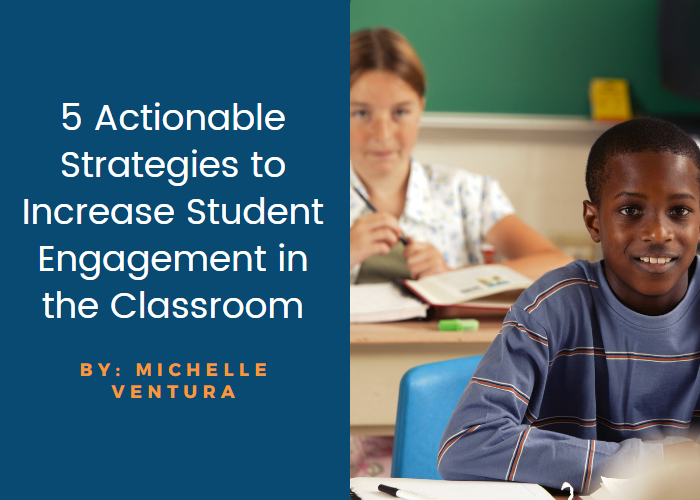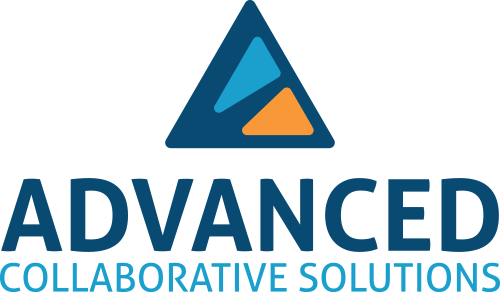5 Actionable Strategies to Increase Student Engagement in the Classroom

By: Michelle Ventura
Getting to the Root of Student Engagement
Compliance and silence may indicate a "well-behaved" class, but do they reflect genuine student engagement? Before digging into the topic of student engagement, let's look inward for a moment. When are you most engaged in your work and learning? What are the conditions that motivate you and keep your interest piqued? What are things that demotivate or disengage you from your work? With this frame, you can likely draw parallels between your levels of personal engagement and that of students. The best learning happens in moments that feel challenging, relatable, relevant, and sometimes a little noisy and messy.
Engaging today's students in their learning requires much more than entertaining lessons, high-energy teaching, or fun brain breaks. True student engagement goes much deeper than simply paying attention or completing their work. Instead, when we regularly achieve high levels of student engagement, learners reap the benefits in many facets of their lives – they build stronger habits of mind, curiosity, and resilience, and all of these have compounding positive effects later in college, work, and life.
We recently conducted student-focus interviews to gather their thoughts and identify trends in students' perceptions of effective and ineffective teaching. Their responses are telling:
What are some examples of the best teaching you have experienced at this school?
- The teacher had rules, but she lets you make decisions based on those rules.
- The teachers try to get to know us, not just at school, but about our lives away from school.
- Teachers understand that we need to be prepared for life, like being responsible with our money.
- Teachers should make learning challenging.
- My teachers share the success criteria.
- We can talk to other students.
Whether it's academic research or on-the-ground conversations with students, the case for focusing on student engagement is a strong one.
What Does It Mean for a Student to Be Engaged?
Educators tend to have varying definitions of and expectations for student engagement. Let's level set using educational neuroscience expert Dr. David Sousa's definition of student engagement: "the amount of attention, interest, curiosity, and positive emotional connections that students have when they are learning, whether in the classroom or on their own."
Additionally, Dr. Sousa points out that engaged students:
- Have more motivation to participate in class
- Enjoy achieving their learning goals
- Are more likely to persist through challenges in learning
- Feel intrinsically motivated to gain new and deeper understanding
For another perspective, John Antonetti and Terri Stice define engagement in two ways in their book Powerful Task Design and Engaging Tasks to Level Up Instruction:
- Engagement: when the work has meaning to the learner
- Cognitive engagement: when the learner makes meaning
This is what every educator strives for. We want to lead classrooms that are abuzz with curiosity, brimming with resilience and motivation, and full of students committed to continuous learning ready to face the inevitable bumps and failures that come along with learning and growing.
Our recipe for student engagement requires three essential ingredients:
- Shared attention. Teachers and students attune attention to and between each other consistently to motivate deeper thinking.
- Curiosity and self-connection. A shared sense of wonder and connection to the real-world drives intrinsically motivated learning.
- Challenge. The environment prioritizes rigor, differentiation, and is a safe space to make mistakes.
Cultivating a culture of student engagement is a challenging task. However, there are actionable strategies educators can implement that, in our continued research and study, consistently increase student engagement levels. Read on for five tips that promise to keep your learners engaged.
5 Ways to Amp Up Student Engagement in Your Classroom
- Support students in crafting their own goals. Well-known education researcher John Hattie notes that “[goals have a self-energizing effect if they are appropriately challenging for the student, as they can motivate students to exert effort in line with the difficulty or demands of the goal.”. Hattie similarly encourages educators to maximize this goal-setting process by showing students how to write their own goals. Conduct one-to-one, goal-setting conferences with students to help them create goals that represent an appropriate level of difficulty. The most crucial factor in student goal setting is for teachers to be explicit in their goal-setting instructions. The more detailed the explanation, the better students will grasp the process and understand how to use it to increase their achievement level. In classrooms where teachers give students specific strategies to achieve their goals while providing frequent feedback, students gain confidence and motivation. One strategy to accomplish this is to use a student self-reflection form following the below three steps:
Step 1: Students are given the total points possible from the assessment, and they record their current pre-assessment results on the form.
Step 2: The teacher asks them to set a goal before the second assessment takes place. Students conference with their teacher to determine the steps they will take to achieve their goal.
Step 3: Students record their actual assessment results from the post-assessment and fill out a self-reflection questionnaire.
- Leverage success criteria. We dig into this in much greater detail in this blog post and our book Achievement Teams: How a Better Approach to PLCs Can Improve Student Outcomes and Teacher Efficacy, but here’s the condensed version. Essentially, teachers who clearly and consistently articulate success criteria are able to provide stronger feedback to students, better motivate learners through the focus and clarity that success criteria offer, and more actively engage students in incrementally pursuing mastery. Success criteria build students’ metacognition so that they both learn the content at hand and internalize strong critical thinking skills.
- Increase the cognitive demand and rigor of learning. All too often, when a student struggles, well-meaning educators water down or oversimplify content in an effort to make learning more accessible. However, multiple students have demonstrated that low-achieving students don’t need less rigorous lessons or texts. They actually benefit from learning experiences that engage them in cognitively complex ideas. While designing lessons and tasks, consider the minimal amount of thinking a task will require of learners and ensure this meets the rigor level of corresponding standards and assessments. Use our Engagement Matrix to both design new tasks and lessons or audit the depth of learning your current lessons and tasks require, then adjust accordingly. Tasks must necessitate that students formulate original thoughts about the content and skills in order for deep and transfer learning to occur.
- Use thinking strategies and conversation. Identify the required visible evidence of student understanding, whether that be in writing, multimedia, checks for understanding, or discussion. Our Instructional Strategy Flipbook includes 25 research-based strategies, each selected based on its proven effect on achievement and progress, that have very high probability of raising students’ level of thinking and increasing student achievement. Use this tool as a guide to select strategies appropriate to your class, teaching style, and content. (We have a high-quality print version, too!).
- Design lessons with engaging qualities and personal connection. Think back to those initial questions posed in the beginning of this post – When are you most engaged in your work and learning? What are the conditions that motivate you and keep your interest piqued? What are things that demotivate or disengage you from your work? It’s likely that your answers to these questions reflect one commonality – as learners, our level of engagement (or lack thereof) is a direct reflection of the lesson design and the relationship we have with our instructor. To initially hook learners (and keep them engaged throughout learning), lessons should be designed to allow students to make personal connections. Students are more likely to invest in learning that feels relevant and relatable. Further, and as beloved educator Rita Pierson once said in her famous Ted Talk, “kids don’t learn from people they don’t like.”
Engage Students and Teachers with Achievement Teams!
Achievement Teams replicate the same sense of student motivation we aim for within a teaching team by harnessing teachers’ instructional efforts toward a common goal using our Achievement Teams approach. When Achievement Teams build collective teacher efficacy and become more engaged in their students’ data, progress, and achievement, this high level of engagement trickles down to students through stronger instructional strategies, more targeted planning, and a focus on growth.
Looking for more support in engaging educators and learners? Grab a copy of our book Achievement Teams: How a Better Approach to PLCs Can Improve Student Outcomes and Teacher Efficacy or get in touch with us and let’s talk about how we can enhance your system’s culture of engagement together.

